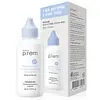What's inside
What's inside
 Key Ingredients
Key Ingredients

 Benefits
Benefits

 Concerns
Concerns

No concerns
 Ingredients Side-by-side
Ingredients Side-by-side

Water
Skin ConditioningPanthenol
Skin ConditioningButylene Glycol
HumectantNiacinamide
SmoothingMethylpropanediol
Solvent1,2-Hexanediol
Skin ConditioningTerminalia Ferdinandiana Fruit Extract
AntioxidantHydrolyzed Sponge
Skin ConditioningArginine
MaskingAcrylates/C10-30 Alkyl Acrylate Crosspolymer
Emulsion StabilisingPropanediol
SolventPolyglyceryl-10 Laurate
Skin ConditioningCentella Asiatica Extract
CleansingCarbomer
Emulsion StabilisingAllantoin
Skin ConditioningXanthan Gum
EmulsifyingEthylhexylglycerin
Skin ConditioningAdenosine
Skin ConditioningDisodium EDTA
Sodium Hyaluronate
HumectantMadecassoside
AntioxidantAsiaticoside
AntioxidantMadecassic Acid
Skin ConditioningAsiatic Acid
Skin ConditioningWater, Panthenol, Butylene Glycol, Niacinamide, Methylpropanediol, 1,2-Hexanediol, Terminalia Ferdinandiana Fruit Extract, Hydrolyzed Sponge, Arginine, Acrylates/C10-30 Alkyl Acrylate Crosspolymer, Propanediol, Polyglyceryl-10 Laurate, Centella Asiatica Extract, Carbomer, Allantoin, Xanthan Gum, Ethylhexylglycerin, Adenosine, Disodium EDTA, Sodium Hyaluronate, Madecassoside, Asiaticoside, Madecassic Acid, Asiatic Acid
Water
Skin ConditioningGlycerin
HumectantButylene Glycol
HumectantEthylhexyl Palmitate
EmollientCetyl Ethylhexanoate
Emollient1,2-Hexanediol
Skin ConditioningSorbitol
HumectantPanthenol
Skin ConditioningPolyglyceryl-10 Oleate
Skin ConditioningCeramide NP
Skin ConditioningMadecassoside
AntioxidantAnthemis Nobilis Flower Extract
MaskingCarbomer
Emulsion StabilisingHydrogenated Lecithin
EmulsifyingTromethamine
BufferingDipropylene Glycol
HumectantEthylhexylglycerin
Skin ConditioningCetearyl Olivate
Disodium EDTA
Sorbitan Olivate
EmulsifyingCaprylic/Capric Triglyceride
MaskingWater, Glycerin, Butylene Glycol, Ethylhexyl Palmitate, Cetyl Ethylhexanoate, 1,2-Hexanediol, Sorbitol, Panthenol, Polyglyceryl-10 Oleate, Ceramide NP, Madecassoside, Anthemis Nobilis Flower Extract, Carbomer, Hydrogenated Lecithin, Tromethamine, Dipropylene Glycol, Ethylhexylglycerin, Cetearyl Olivate, Disodium EDTA, Sorbitan Olivate, Caprylic/Capric Triglyceride
Ingredients Explained
These ingredients are found in both products.
Ingredients higher up in an ingredient list are typically present in a larger amount.
1,2-Hexanediol is a synthetic liquid and another multi-functional powerhouse.
It is a:
- Humectant, drawing moisture into the skin
- Emollient, helping to soften skin
- Solvent, dispersing and stabilizing formulas
- Preservative booster, enhancing the antimicrobial activity of other preservatives
Butylene Glycol (or BG) is used within cosmetic products for a few different reasons:
Overall, Butylene Glycol is a safe and well-rounded ingredient that works well with other ingredients.
Though this ingredient works well with most skin types, some people with sensitive skin may experience a reaction such as allergic rashes, closed comedones, or itchiness.
Learn more about Butylene GlycolCarbomer is a polymer of acrylic acid. Its main role is to create a gel consistency.
A high amount of carbomer can cause pilling or balling up of products. Don't worry, most products contain 1% or less of carbomer.
Disodium EDTA plays a role in making products more stable by aiding other preservatives.
It is a chelating agent, meaning it neutralizes metal ions that may be found in a product.
Disodium EDTA is a salt of edetic acid and is found to be safe in cosmetic ingredients.
Learn more about Disodium EDTAEthylhexylglycerin (we can't pronounce this either) is commonly used as a preservative and skin softener. It is derived from glyceryl.
You might see Ethylhexylglycerin often paired with other preservatives such as phenoxyethanol. Ethylhexylglycerin has been found to increase the effectiveness of these other preservatives.
Madecassoside comes from the super popular skin-soothing ingredient, Centella asiatica. It is one of four active compounds found in the extract of Centella Asiatica.
Madecassoside has antioxidant, anti-inflammatory, and hydrating properties. It contains fatty acids, amino acids, beta-carotene, and phytochemicals.
One study found using Madecassoside with ascorbic acid helped reduce the signs of aging and improved skin hydration.
Learn more about MadecassosidePanthenol is a common ingredient that helps hydrate and soothe the skin. It is found naturally in our skin and hair.
There are two forms of panthenol: D and L.
D-panthenol is also known as dexpanthenol. Most cosmetics use dexpanthenol or a mixture of D and L-panthenol.
Panthenol is famous due to its ability to go deeper into the skin's layers. Using this ingredient has numerous pros (and no cons):
Like hyaluronic acid, panthenol is a humectant. Humectants are able to bind and hold large amounts of water to keep skin hydrated.
This ingredient works well for wound healing. It works by increasing tissue in the wound and helps close open wounds.
Once oxidized, panthenol converts to pantothenic acid. Panthothenic acid is found in all living cells.
This ingredient is also referred to as pro-vitamin B5.
Learn more about PanthenolWater. It's the most common cosmetic ingredient of all. You'll usually see it at the top of ingredient lists, meaning that it makes up the largest part of the product.
So why is it so popular? Water most often acts as a solvent - this means that it helps dissolve other ingredients into the formulation.
You'll also recognize water as that liquid we all need to stay alive. If you see this, drink a glass of water. Stay hydrated!
Learn more about Water